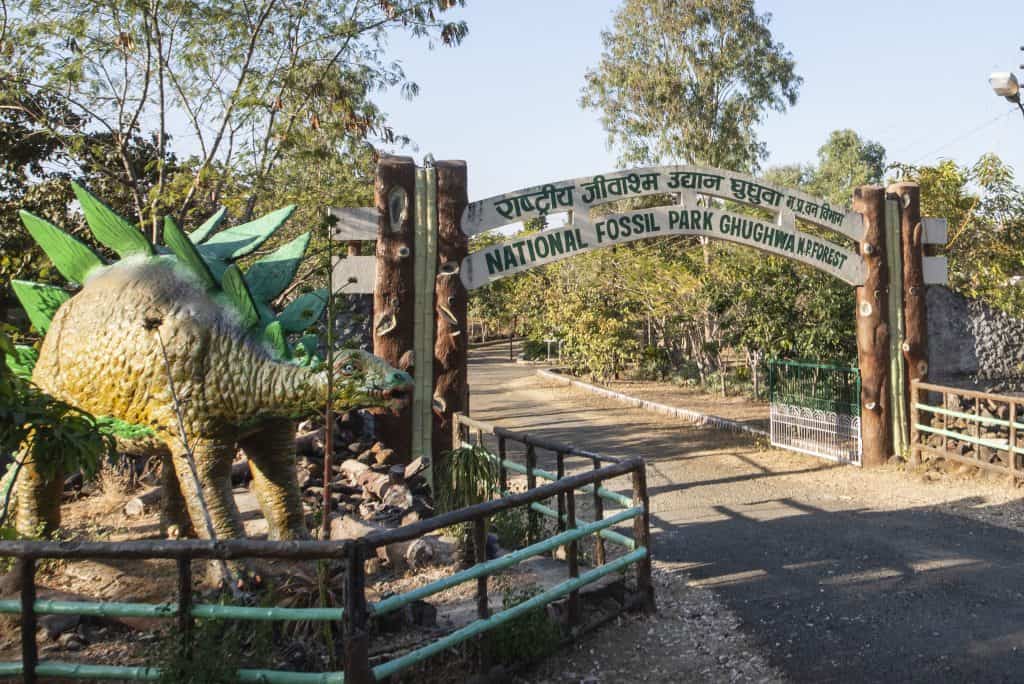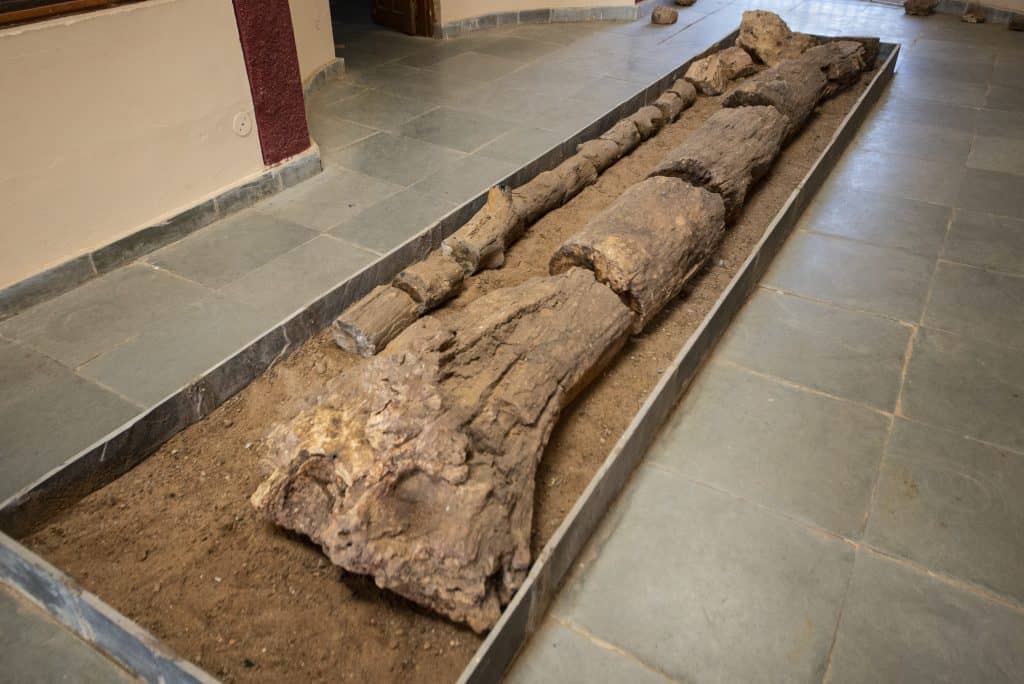Ghughua Fossil National Park, nestled in the scenic landscapes of Madhya Pradesh, is a remarkable testament to Earth’s ancient botanical heritage.

Tucked away in the quiet corners of Dindori district, between the wildlife giants of Kanha and Bandhavgarh, this hidden gem in Madhya Pradesh takes you back 65 million years—to an era when dinosaurs roamed the Earth and tropical forests blanketed Central India.
An Unearthed Treasure of 65 Million Years
This exclusive fossil park is home to plant fossils that date back approximately 65 million years, spanning from the Upper Cretaceous to the early Tertiary period—a critical phase in Earth’s vegetational evolution. These fossils belong predominantly to dicotyledons and palm families, including rare species such as ancient Eucalyptus, indigenous to Australia, which offers compelling evidence of the legendary Gondwana Supercontinent that once connected the southern landmasses.
The park’s collection comprises exquisitely preserved fossils of woody plants, climbers, leaves, flowers, fruits, and seeds. Notable among these are fossilized remnants of Date Palm, Jamun, Banana, Rudraksh, and Aonla, plants that narrate a vivid story of a dramatically different prehistoric climate in Central India—one that was far more humid and lush than today’s dry terrain.
Fossils: Historical Discovery and Scientific Significance
The discovery of these invaluable fossils traces back to 1970, when Dr. Dharmendra Prasad, then Statistical Officer of Mandla district and honorary secretary of the District Archaeology Union, first identified these plant fossils. Collaborating with eminent paleobotanists such as Dr. M.B. Bande from the Birbal Sahni Institute of Paleobotany, Lucknow, and scientists from Jabalpur’s Science College, the fossils were scientifically analyzed and catalogued. This pioneering work elevated the region to the global fossil map, attracting scientists, researchers, students, and tourists alike.

Recognizing the park’s exceptional importance, the Madhya Pradesh government officially declared the site a National Fossil Park in 1983. Since then, it has served both as a sanctuary for fossil preservation and an educational platform for public engagement.
Natural Context and Surroundings
Situated within the rugged, hilly terrain of Dindori, the park is surrounded by a sparsely populated region where agriculture is limited due to poor soil conditions. The local population largely engages in artisan crafts and migratory work in nearby cities, preserving a tranquil backdrop to this paleobotanical haven.
Intriguingly, alongside plant fossils, remains of shell-bearing fauna have been discovered, suggesting that this area once experienced significantly higher humidity and rainfall levels, underscoring the profound climatic and geographical shifts over millions of years.
Ghughua Fossil National Park: A Geological Treasure Trove in Dindor
Located about 70 km from Dindori town, lies a Fossil Park quietly nestled in the village of Ghughwa, covering an expanse of 75 acres. The park is a remarkable repository of ancient flora, showcasing fossilised plant specimens . These include petrified trunks of gymnosperms, angiosperms, monocotyledons, and even bryophytes—preserved in stunning detail.
This exclusive fossil park is home to plant fossils that date back approximately 65 million years, spanning from the Upper Cretaceous to the early Tertiary period—a critical phase in Earth’s vegetational evolution. These fossils belong predominantly to dicotyledons and palm families, including rare species such as ancient Eucalyptus, indigenous to Australia, offering compelling evidence of the legendary Gondwana Supercontinent that once connected the southern landmasses.
The fossil diversity reflects both the Jurassic and Cretaceous eras, depending on the time frame of the supercontinent Pangaea’s split into Laurasia and Gondwana. Their presence in Central India points to a time when the region’s climate was vastly different, undergoing dramatic geographic and ecological changes.
Fossil Discoveries and Park Establishment
The first fossils in this area were unearthed in 1970. Following scientific validation of their age and significance, efforts were initiated to create a proper conservation platform. In 1983, the Fossil National Park was officially established, marking a pivotal step in protecting India’s palaeobotanical wealth.
Today, the park showcases exceptionally well-preserved fossils of woody plants, climbers, leaves, flowers, fruits, and seeds. Informative panels accompany the exhibits, helping visitors understand their significance. The abundance of dicotyledon and palm fossil wood is particularly striking, as these species are not found in the region today—underscoring the radical climatic shifts over millions of years.
The fossils represent a crucial chapter in India’s vegetational evolution. Though their modern counterparts can now be seen elsewhere in the world, these specimens offer insights into ancient ecosystems and their transformation over geological time. This is not just a scientific reserve—it’s a living chronicle of Earth’s journey through ages past.
The Baigas: Guardians of a Timeless Land
Dindori district, where the park is located, is also home to the Baiga tribe—one of the most ancient and respected tribal communities of India. Declared as a “National Human,” the Baigas represent the deep-rooted cultural heritage of this land. With its moderate climate, undulating hills, valleys, flowing streams, and dense forests, the district is fast emerging as a serene eco-tourism hotspot.
Exploring Ghughua: What to Expect
Visitors to Ghughua Fossil National Park in Madhya Pradesh India can explore open-air platforms where fossils are carefully displayed with informative placards, offering insightful commentary on the prehistoric vegetation and environment. A modest yet informative museum onsite houses fossilized seeds, leaves, and other artifacts, making it a valuable resource for enthusiasts and scholars.
The park is open year-round, from sunrise to sunset, with a nominal entrance fee supporting its maintenance. Visitors are required to purchase entrance tickets, with different pricing for Indian and foreign tourists. The site is actively promoted by the Madhya Pradesh Tourism Department as a must-visit destination for nature lovers, students, and curious minds alike.
Given the proximity to other major wildlife sanctuaries, most visitors combine their fossil park visit with trips to Kanha, Bandhavgarh, or Amarkantak, particularly during the peak tourist season between October and June. The nearest railway station is Umaria (approximately 60 km away), while the closest airport is Jabalpur, about 130 km from the park.
The Road Ahead for Ghughua National Park
The Madhya Pradesh Tourism Board is putting the spotlight on the Fossil National Park, branding it as one of the state’s most overlooked natural treasures. With a focus on elevating the visitor experience, plans are in motion to enhance infrastructure, improve signage, and develop interactive, science-backed interpretation centers. These efforts aim not just to draw more tourists, but to transform Ghughua into a vibrant hub for education, research, and eco-tourism — bridging the gap between ancient history and modern discovery.

Why Visit Ghughua Fossil National Park?
- A rare glimpse into 65 million years of Earth’s botanical history
- Fossils that reveal the story of the Great Gondwana Supercontinent
- Well-preserved fossils of ancient plants, many of which no longer grow in Central India
- Proximity to major wildlife reserves, making it a convenient stop for nature lovers and history buffs
- Opportunities for scientific learning and exploration in a serene natural setting
How to Reach Ghughua Fossil National Park
By Air
The nearest airport is in Jabalpur, about 110 km away (approximately 2.5 hours by road). Jabalpur Airport (IATA: JLR) is well connected to major cities like Delhi, Mumbai, and Kolkata. From the airport, taxis are available for onward travel to the park.
By Train
Umaria Railway Station (UMR), located about 70 km northeast of the park, is the closest railhead. However, Jabalpur Railway Station (JBP), at a distance of 105 km, offers far better connectivity to key cities such as Mumbai, Delhi, Ahmedabad, Bengaluru, Jaipur, and Varanasi. Taxi services are readily available from both stations.
By Road
The park is best accessed by road and is well connected to nearby towns such as Shahpura, Dindori, Mandla, Jabalpur, Umaria, Amarkantak, Bandhavgarh, and Kanha. While limited bus services are available, taxis or private vehicles are the most convenient and reliable options throughout the year.
The Fossil National Park is more than just a destination—it is a timeless portal connecting the present to the prehistoric world, inviting you to witness the enduring legacy of Earth’s ancient green tapestry.
Read More: Latest




1 Comment